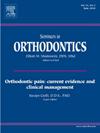Unveiling incidental findings: A clinical review of a giant aneurysm detected by CBCT imaging
IF 2
4区 医学
Q2 DENTISTRY, ORAL SURGERY & MEDICINE
引用次数: 0
Abstract
Cone beam computed tomography (CBCT) is an advanced imaging modality that has transformed the field of dentistry with its high-resolution and three-dimensional (3D) imaging capabilities. It has proven to be an invaluable tool for diagnostic and treatment planning purposes, and the increased use of large CBCT imaging has led to a corresponding rise in unexpected incidental findings, especially in orthodontics and implant planning. These incidental findings may be clinically significant and indicate medical emergencies requiring immediate intervention or referral. This clinical review presents a case of a 64-year-old female who was referred for a CBCT examination to assess a radiopacity in the left maxillary sinus. Incidentally, the scan revealed a giant internal carotid artery (ICA) aneurysm in the right middle cranial fossa. Prompt recognition and proper management led to a successful intervention using endovascular surgical treatment, potentially averting a catastrophic rupture. This case demonstrates the critical role of CBCT imaging in identifying potentially life-threatening conditions beyond the primary area of interest. In our review, we underscore the ethical responsibilities of dental practitioners in managing incidental findings. Practitioners must ensure that CBCT scans in their entirety are fully assessed and interpreted, and must stay current with the guidelines for advanced imaging interpretation. Proper management entails the proper communication and documentation of incidental findings, and subsequent referral to the appropriate specialists. By fulfilling these responsibilities, dental professionals can continue to uphold the highest standards of patient care, reducing the risk of missed diagnoses and enhancing interdisciplinary collaboration for optimal patient outcomes.
揭示偶然发现:CBCT成像发现巨大动脉瘤的临床回顾
锥形束计算机断层扫描(CBCT)是一种先进的成像方式,它以其高分辨率和三维(3D)成像能力改变了牙科领域。它已被证明是诊断和治疗计划目的的宝贵工具,并且大CBCT成像的使用增加导致意外意外发现的相应增加,特别是在正畸和种植体计划中。这些偶然发现可能具有临床意义,表明需要立即干预或转诊的医疗紧急情况。本临床回顾报告一位64岁的女性,她被转介进行CBCT检查以评估左上颌窦的放射性混浊。顺便说一句,扫描显示一个巨大的颈内动脉(ICA)动脉瘤在右中颅窝。及时的识别和适当的处理导致血管内手术治疗的成功干预,潜在地避免了灾难性的破裂。该病例证明了CBCT成像在识别主要感兴趣区域以外的潜在危及生命的疾病方面的关键作用。在我们的回顾中,我们强调牙科医生在处理意外发现方面的道德责任。从业人员必须确保CBCT扫描在整体上得到充分的评估和解释,并且必须保持最新的高级成像解释指南。适当的管理需要适当的沟通和偶然发现的文件,并随后转介给适当的专家。通过履行这些职责,牙科专业人员可以继续维护患者护理的最高标准,减少漏诊的风险,并加强跨学科合作,以获得最佳的患者结果。
本文章由计算机程序翻译,如有差异,请以英文原文为准。
求助全文
约1分钟内获得全文
求助全文
来源期刊

Seminars in Orthodontics
DENTISTRY, ORAL SURGERY & MEDICINE-
CiteScore
2.20
自引率
4.80%
发文量
28
审稿时长
10 days
期刊介绍:
Each issue provides up-to-date, state-of-the-art information on a single topic in orthodontics. Readers are kept abreast of the latest innovations, research findings, clinical applications and clinical methods. Collection of the issues will provide invaluable reference material for present and future review.
 求助内容:
求助内容: 应助结果提醒方式:
应助结果提醒方式:


